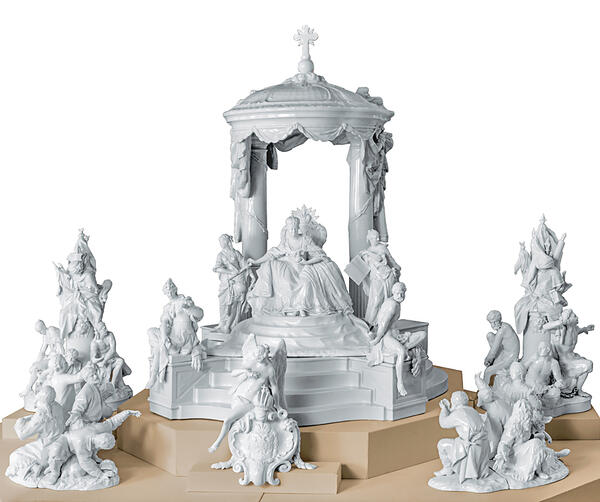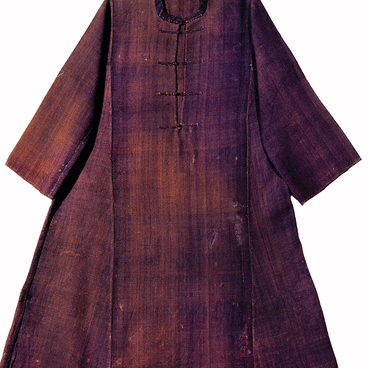The State Historical Museum displays this copy of a table decoration — part of a dessert service that Catherine II received as a gift from the Prussian King Frederick II. The copy was made in 1908. The original exhibit is housed in the State Hermitage Museum.
A miniature figurine of Catherine the Great sits in the central part of the decoration on the imperial throne under a canopy. The empress is surrounded by allegorical figures that represent the virtues and triumphs of her reign. The closest to the throne are Justitia (Law) and Themis (Justice). They symbolize the legislative activity of Catherine. The Greek god Hermes embodies the wisdom of the empress; the goddess of war Bellona celebrates the victories of the Russian army. The goddess of glory Fama is depicted with a laurel wreath in her hands: with it, she adorns the double-headed eagle on the coat of arms of the Russian Empire. Other figures are also placed around the throne: they represent different peoples who lived on the territory of Russia and classes. The composition is surrounded by military trophies and figures of captured Turkish soldiers — a symbol of victory in the war with the Ottoman Empire.
In 1764, Russia and Prussia concluded a defensive alliance against Turkey. To celebrate this event, the monarchs of the two countries repeatedly exchanged diplomatic gifts. Catherine II sent precious furs to Frederick II in 1770. To thank for the expensive gift, the emperor chose items made of German porcelain, which was famous all over the world at that time and was almost as good as Chinese in terms of quality.
The monarch’s wishes were reported to the Berlin Porcelain Manufactory. The craftsmen made dishes and table decorations based on Frederick’s own idea. Catherine the Great received the gift in Tsarskoye Selo on August 3, 1772, and the very next day she sent a letter of gratitude to the Prussian emperor.
The table service was a model for Russian craftsmen, who at that time sought to master the production of porcelain. The Berlin manufactory also made several copies of the entire table decoration and its individual figurines.
A miniature figurine of Catherine the Great sits in the central part of the decoration on the imperial throne under a canopy. The empress is surrounded by allegorical figures that represent the virtues and triumphs of her reign. The closest to the throne are Justitia (Law) and Themis (Justice). They symbolize the legislative activity of Catherine. The Greek god Hermes embodies the wisdom of the empress; the goddess of war Bellona celebrates the victories of the Russian army. The goddess of glory Fama is depicted with a laurel wreath in her hands: with it, she adorns the double-headed eagle on the coat of arms of the Russian Empire. Other figures are also placed around the throne: they represent different peoples who lived on the territory of Russia and classes. The composition is surrounded by military trophies and figures of captured Turkish soldiers — a symbol of victory in the war with the Ottoman Empire.
In 1764, Russia and Prussia concluded a defensive alliance against Turkey. To celebrate this event, the monarchs of the two countries repeatedly exchanged diplomatic gifts. Catherine II sent precious furs to Frederick II in 1770. To thank for the expensive gift, the emperor chose items made of German porcelain, which was famous all over the world at that time and was almost as good as Chinese in terms of quality.
The monarch’s wishes were reported to the Berlin Porcelain Manufactory. The craftsmen made dishes and table decorations based on Frederick’s own idea. Catherine the Great received the gift in Tsarskoye Selo on August 3, 1772, and the very next day she sent a letter of gratitude to the Prussian emperor.
The table service was a model for Russian craftsmen, who at that time sought to master the production of porcelain. The Berlin manufactory also made several copies of the entire table decoration and its individual figurines.



